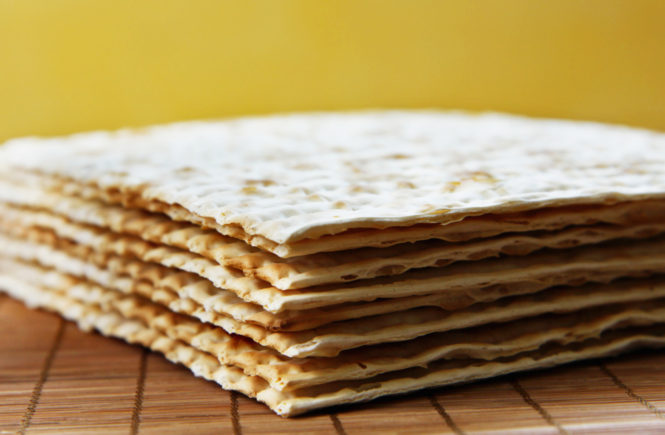- The matzah we eat on Passover reminds us that the Jews left Egypt in a hurry and had no time to let their dough puff up. That’s how they ended up with flatbread, or “matzah.”
- Passover matzah must not become leavened (chametz). And yet, it must be made only of grains that could become leavened! So dry flatbreads made from rice, millet, or other legumes—though they may look like matzah and feel like matzah—are not Passover matzah.
- The matzah flour is quickly mixed with water, rolled out, then pricked with a fork or a similar tool to keep the finished product from puffing up. The resulting flat piece of dough is baked at a high temperature for a few minutes until it develops dark spots, after which it is set aside to cool and, if sufficiently thin, to harden to crispness. From the moment that flour touches water, the entire process of making matzah may take no more than eighteen minutes, after which time the flour is considered leavened (chametz), and is no longer kosher for Passover.
- Matzah made with fruit juices, oil, honey, milk, or eggs is called matzah ashira—“rich matzah.” Such matzah is unsuitable for Passover, since the Torah requires us to eat “poor bread,” the bland matzah of flour and water on Passover (Pesachim 35a and Rashi).
- The water used for making matzah must be drawn before sunset and allowed to cool overnight before being used. The flour in shmurah (guarded) matzah is supervised from the moment of harvest to ensure that it never comes into contact with any liquid. That shmurah flour must be ground no later than three days prior to baking the matzah, giving the flour time to cool down from the grinding process.
- An invention in 1855 of a matzah-dough-rolling machine cut down on the dough’s prep time and made mass production possible. The later invention of machine baked matzah became a hot-button issue for nineteenth-century Jewish authorities. Rabbinic authorities around the world weighed in on the issue—the proponents arguing that the machines made it easier to abide by the eighteen-minute rule, and that it made matzah more affordable. These discussions were not easily resolved—the opponents argued that the many moving parts of the machine made it hard to clean out the remnants of dough, that handmade matzah provided kneading jobs for the poor. The Chasidic rabbinic authorities insisted on using only handmade matzah.
- Although Passover comes in the spring—usually April—Passover matzah bakeries typically begin baking matzah in December.
- The price of a one-pound box of hand-baked shmurah matzah is between $18-$27 and contains anywhere from seven to nine matzahs depending on their thickness and density. On average, an individual who consumes matzah in place of bread during the week of Passover will need about 2-2.5 pounds of matzah.
- Machine-baked matzahs are generally of uniform size and weight—approximately 1.2 ounces (36 grams). Hand-baked matzahs vary in both size and density. Nonetheless, the average hand-baked matzah has a diameter of 10-10.5 inches and weighs 2.3 ounces (66 grams).
- Kosher-for-Passover matzah by any name is still a mitzvah when consumed on Passover. The Torah calls it “bread of affliction”; the Zohar calls it “bread of faith” and sometimes, “bread of healing.”



Source: http://lubavitch.com/news/article/2114569/DID-YOU-KNOW.html


